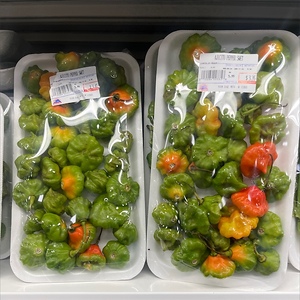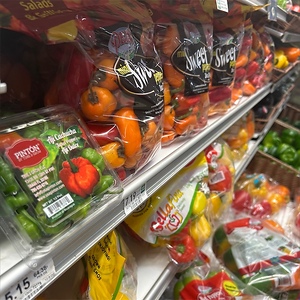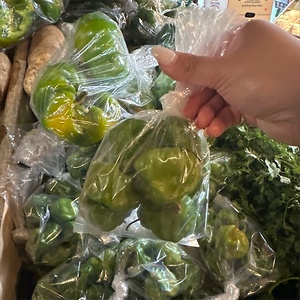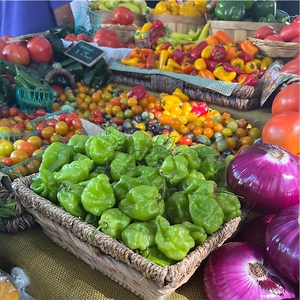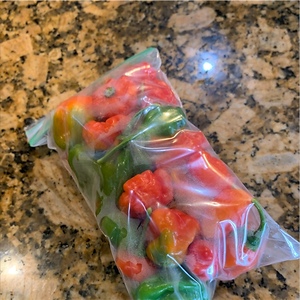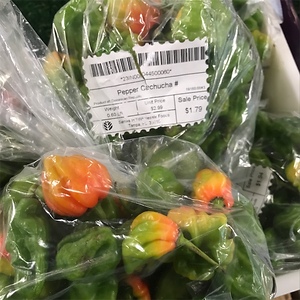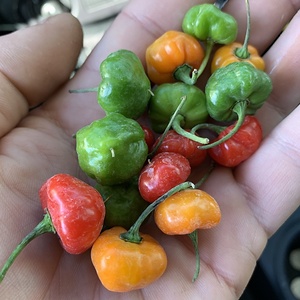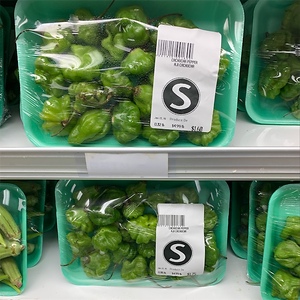

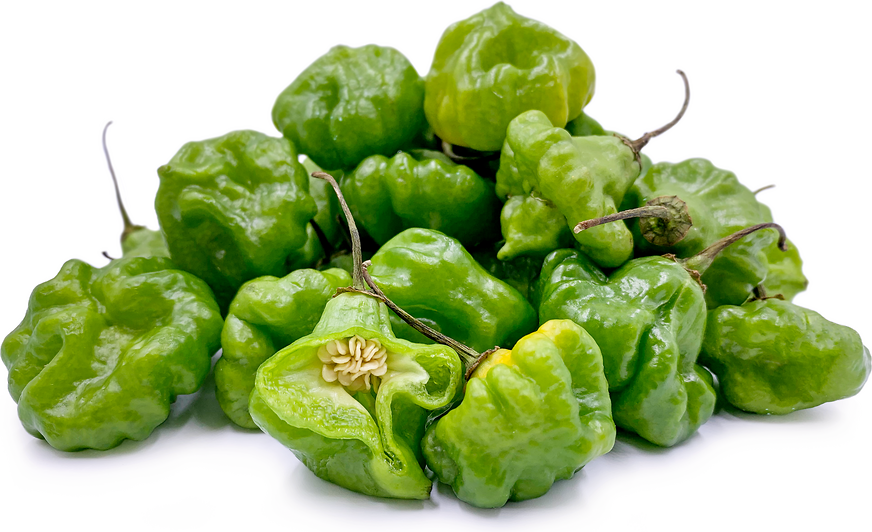
Cachucha Peppers
Estimated Inventory, lb : 0
Description/Taste
Cachucha chile peppers widely vary in shape depending on cultivation habits, soil, and the climate it is grown in, but the pods are generally squat, oblong, to round with a creased and wrinkled appearance. Similar in shape to a habanero pepper, the peppers average ten centimeters in width and 5 to 7 centimeters in length and sometimes resemble a small hat. The medium-thick skin is glossy, and when young, the pepper bears hues of light to dark green, transforming to yellow-orange, and then to red when mature. Underneath the skin, the flesh matches the exterior skin tone, depending on maturity, and is crisp and aqueous, encasing a central cavity filled with a few small, round, cream-colored seeds. Cachucha chile peppers are aromatic and crunchy with sweet, fruity, grassy, and smoky flavors mixed with mild heat.
Seasons/Availability
Cachucha chile peppers are available year-round, with a peak season in the summer through fall.
Current Facts
Cachucha chile peppers, botanically classified as Capsicum chinense, are brightly-colored, wrinkled pods that grow on leafy shrubs and are members of the Solanaceae or nightshade family. Also known as Ajícito, Ají Dulce, Ají Cachucha, Ají Gustoso, and Sweet peppers, Cachucha chile peppers have a mild heat ranging 0 to 1,000 SHU on the Scoville scale, which is similar to the spice of poblano peppers. The word Cachucha means “hat” in Spanish, which is used to describe the pepper’s cap-like shape. Cachucha chile peppers are extremely popular in Puerto Rican, Cuban, and Dominican cooking, which are cuisines that value peppers with sweet flavors and mild spice. Though Cachucha chile peppers are known to be mild, they have recently earned an unexpected reputation of sometimes being very spicy due to the Cachucha chile pepper being grown near and naturally cross-pollinating with other spicy peppers such as habaneros. This recent spice variation in the pepper has negatively impacted sales in the United States because consumers are becoming skeptical of the quality of the peppers as there is no way to determine the level of heat that each pepper carries by appearance alone.
Nutritional Value
Cachucha chile peppers are an excellent source of vitamin C, which is an antioxidant that helps boost collagen production in the body, and are a good source of fiber, potassium, magnesium, and vitamins A and B6. The peppers also contain trace amounts of iron, calcium, and capsaicin.
Applications
Cachucha chile peppers are best suited for both raw and cooked applications such as sautéing, roasting, and stewing. When fresh, the peppers can be chopped into salsas, blended into sauces, used to flavor marinades, or tossed into green salads. Cachucha chile peppers are most popularly roasted and are used to flavor soups, stews, rice, beans, and cooked meats. They can also be used as a filling for tamales, stuffed with herbs, cheeses, or meats, sliced and mixed into Asian soba noodle dishes, or lightly cooked in omelets with sundried tomato. In Venezuela, Cachucha chile peppers are used in the national dish known as hallaca, which is a mixture of meat blended with olives, capers, and raisins that is stuffed into corn dough, wrapped in plantain leaves, and boiled. Cachucha chile peppers pair well with cheeses such as parmesan or asadero, tomatoes, onions, garlic, baby kale, carrots, galangal, potatoes, lime juice, herbs such as cilantro, oregano, and parsley, eggs, and meats such as poultry, beef, and pork. The peppers will keep up to one week when loosely stored whole and unwashed in a paper or plastic bag in the refrigerator.
Ethnic/Cultural Info
In the Caribbean and Latin America, Cachucha chile peppers are well-known for their use in sofrito, which is a combination of cooked vegetables and herbs used similarly to mirepoix. Sofrito refers to a style of cooking which consists of lightly sautéing and was introduced into the Caribbean by Spanish colonists in the 1400s. There are many different variations of sofrito with families traditionally passing down their own versions, but in general Cachucha chile peppers are chopped and blended with bell peppers, tomatoes, onions, garlic, and cilantro and used as the base for many different recipes including soups, stews, rice, and bean dishes. In Puerto Rico, sofrito is such a common foundation in everyday cooking that many locals grow the ingredients in their home gardens to have fresh, flavorful sofrito always on hand. There are also prepackaged sofrito bundles in markets for locals to easily take home for their daily cooking.
Geography/History
Cachucha chile peppers are believed to be native to South America, specifically to the Brazilian Amazon, and have been growing wild since ancient times. The peppers were then spread to the Caribbean and Central America via Spanish colonists and Brazilian immigrants. Today Cachucha chile peppers can be found at local markets and specialty grocers across South America, Central America, the Caribbean, Mexico, and also in the Northeastern United States.
Recipe Ideas
Recipes that include Cachucha Peppers. One
| Adriana's Best Recipes |
|
Spicy Cuban Black Beans |



